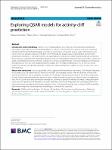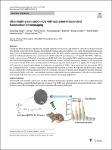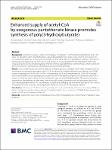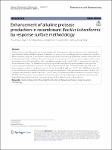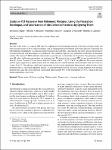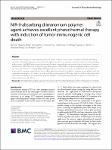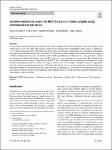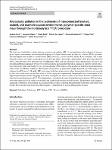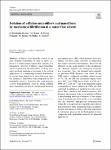Search
Author
- Carlos, Alegría (2)
- Carlos, Seara (2)
- David, Orden (2)
- Klaus, Bretterbauer (2)
- next >
Subject
Date issued
Has File(s)
- true (287)
Search Results
Pairs of similar compounds that only differ by a small structural modification but exhibit a large difference in their binding affinity for a given target are known as activity cliffs (ACs). It has been hypothesised that QSAR models struggle to predict ACs and that ACs thus form a major source of prediction error. However, the AC-prediction power of modern QSAR methods and its quantitative relationship to general QSAR-prediction performance is still underexplored. We systematically construct nine distinct QSAR models by combining three molecular representation methods (extended-connectivity fingerprints, physicochemical-descriptor vectors and graph isomorphism networks) with three regression techniques (random forests, k-nearest neighbours and multilayer perceptrons); we then use ea... |
Current and future diagnostics urgently need imaging agents that are non-toxic and superior to clinically used small molecule dyes. Herein, we have developed luminescent green light-emitting carbon dots (GCDs) via a single-step hydrothermal reaction using a low-cost chemical precursor, p-toluenesulfonic acid. The GCDs exhibit excitation-independent fluorescence (FL) emission with the photoluminescence quantum yield of 70% and no FL quenching up to 1.25 mg/mL. The GCDs exhibit negligible cytotoxicity up to 250 µg/mL concentration in RAW 264.7 cells. Interestingly, GCDs exhibit an excitation-independent and concentration-dependent fluorescence emission behaviour. In vitro, the peak emission was obtained at 520 nm using the excitation at 430 nm. |
Coenzyme A (CoA) is a carrier of acyl groups. This cofactor is synthesized from pantothenic acid in five steps. The phosphorylation of pantothenate is catalyzed by pantothenate kinase (CoaA), which is a key step in the CoA biosynthetic pathway. To determine whether the enhancement of the CoA biosynthetic pathway is effective for producing useful substances, the effect of elevated acetyl-CoA levels resulting from the introduction of the exogenous coaA gene on poly(3-hydroxybutyrate) [P(3HB)] synthesis was determined in Escherichia coli, which express the genes necessary for cyanobacterial polyhydroxyalkanoate synthesis (phaABEC). |
Alkaline protease is widely used in the food, detergent, and pharmaceutical industries because of its comparatively great hydrolysis ability and alkali tolerance. To improve the ability of the recombinant Bacillus licheniformis to produce alkaline protease, single-factor experiments and response surface methodology (RSM) were utilized to determine and develop optimal culture conditions. The results showed that three factors (corn starch content, soybean meal content, and initial medium pH) had significant effects on alkaline protease production (P < 0.05), as determined through the Plackett‒Burman design. The maximum enzyme activity was observed with an optimal medium composition by central composite design (CCD): corn starch, 92.3 g/L; soybean meal, 35.8 g/L; and initial medium pH,... |
The aim of this study is to separate PET flakes by applying floatation technique, initially from binary polymer blends and later from the mixture of five common polymers such as polypropylene, polyethylene, poly(vinyl chloride), polstyrene and poly(ethylene terephthalate). A connection line between polymer and fiber is presumed in this study, because the dyeing of recovered polyester with three disperse dyes followed. The separation of plastics was performed in a Plexiglas air floatation column. The Lutensol® TO 8 surfactant of non-ionic origin was used to selectively wet the plastics. The parameters studied were pH values, surfactant concentration and treatment time. The dyeing of the recovered PET was performed with Serilene Blue RL, Serisol Crimson ECF and Serisol Yellow ECF dyes... |
Photothermal therapy has shown great promise for cancer treatment and second near-infrared (NIR-II) -absorbing particles could further improve its precision and applicability due to its superior penetration depth and new imaging ability. Herein, high NIR-II-absorbing polymer particles were prepared by using soluble isobutyl-substituted diammonium borates (P-IDI). The P-IDI showed stronger absorption at 1000–1100 nm, which exhibited excellent photostability, strong photoacoustic imaging ability and high photothermal conversion efficiency (34.7%). The investigations in vitro and in vivo demonstrated that the excellent photothermal effect facilitated complete tumor ablation and also triggered immunogenic cell death in activation of the immune response. The high solubility and excellent... |
Sensitive ratiometric sensor for Al(III) detection in water samples using luminescence or eye-vision A facile, quick, and sensitive ratiometric luminescence sensor is designed for detection aluminum ions in water samples using luminescence or eye-vision. This approach relies on the emission change of the europium(III) complex with 3-(2-naphthoyl)-1,1,1,-trifluoro acetone (3-NTA) after interaction with various concentration of aluminum ions. The addition of aluminum ions suppressed the Eu(III) emission at 615 nm under 333 nm excitation, while simultaneously enhancing the ligand emission at 480 nm. Optimum detection was obtained in methanol. The quantification of aluminum ions using ratiometric method was determined by plotting the luminescence ratio (F480nm/F615nm) versus aluminum ions concentration. The calibration plot was obtained within the range 0.1–100 µM with LOD = 0.27 µM. |
Scanning transitiometry is an important calorimetric method co-invented by Jean-Pierre E. Grolier and Stanisław L. Randzio. Transitiometry enables to measure highly sensitive under high-pressure and high-temperature conditions. Nowadays, process modelling is a tool of increasing importance beyond the process of understanding process dynamics. For a valid modelling approach, a reliable data base at process conditions is required. Many processes are carried out at high temperature and pressure. Under such harsh conditions, comparatively few methods can be applied and thus limited kinetic parameters are known. |
The total mass of individual synthetic polymers present as microplastic (MP < 2 mm) pollutants in the sediments of interconnected aquatic environments was determined adopting the Polymer Identification and Specific Analysis (PISA) procedure. The investigated area includes a coastal lakebed (Massaciuccoli), a coastal seabed (Serchio River estuarine), and a sandy beach (Lecciona), all within a natural park area in Tuscany (Italy). |
Isolation of cellulose microfibers and nanofibers by mechanical fibrillation in a water-free solvent Cellulose from vegetable sources is the most abundant biopolymer on earth. In plants, cellulose is a reinforcement element that conforms to a hierarchical structure. Cellulose micro-/nanofibers can be isolated from the cell wall by top-down strategies involving mechanical processes to be used in applications as a reinforcing material. Nonetheless, its use has been limited as its extraction in an aqueous medium is unfavorable when employed in low-hydrophilic matrices. |

